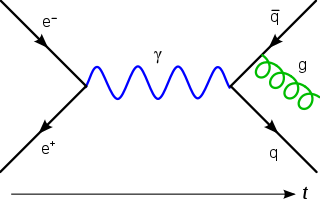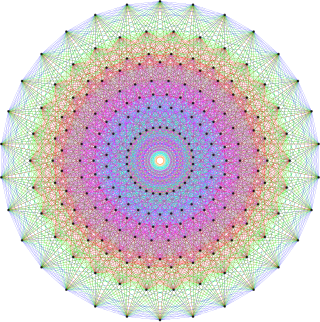In mechanics and geometry, the 3D rotation group, often denoted SO(3), is the group of all rotations about the origin of three-dimensional Euclidean space under the operation of composition.

In probability theory and statistics, the beta distribution is a family of continuous probability distributions defined on the interval [0, 1] in terms of two positive parameters, denoted by alpha (α) and beta (β), that appear as exponents of the variable and its complement to 1, respectively, and control the shape of the distribution.
In mathematics, a Lie superalgebra is a generalisation of a Lie algebra to include a Z2‑grading. Lie superalgebras are important in theoretical physics where they are used to describe the mathematics of supersymmetry. In most of these theories, the even elements of the superalgebra correspond to bosons and odd elements to fermions.

Second quantization, also referred to as occupation number representation, is a formalism used to describe and analyze quantum many-body systems. In quantum field theory, it is known as canonical quantization, in which the fields are thought of as field operators, in a manner similar to how the physical quantities are thought of as operators in first quantization. The key ideas of this method were introduced in 1927 by Paul Dirac, and were later developed, most notably, by Pascual Jordan and Vladimir Fock. In this approach, the quantum many-body states are represented in the Fock state basis, which are constructed by filling up each single-particle state with a certain number of identical particles. The second quantization formalism introduces the creation and annihilation operators to construct and handle the Fock states, providing useful tools to the study of the quantum many-body theory.
In quantum mechanics, the particle in a one-dimensional lattice is a problem that occurs in the model of a periodic crystal lattice. The potential is caused by ions in the periodic structure of the crystal creating an electromagnetic field so electrons are subject to a regular potential inside the lattice. It is a generalization of the free electron model, which assumes zero potential inside the lattice.

In probability theory and statistics, the inverse gamma distribution is a two-parameter family of continuous probability distributions on the positive real line, which is the distribution of the reciprocal of a variable distributed according to the gamma distribution.

In mathematics, a differentiable manifold is a type of manifold that is locally similar enough to a vector space to allow one to apply calculus. Any manifold can be described by a collection of charts (atlas). One may then apply ideas from calculus while working within the individual charts, since each chart lies within a vector space to which the usual rules of calculus apply. If the charts are suitably compatible, then computations done in one chart are valid in any other differentiable chart.
In mathematics, the Fubini–Study metric is a Kähler metric on projective Hilbert space, that is, on a complex projective space CPn endowed with a Hermitian form. This metric was originally described in 1904 and 1905 by Guido Fubini and Eduard Study.
In mathematics, in particular in algebraic geometry and differential geometry, Dolbeault cohomology (named after Pierre Dolbeault) is an analog of de Rham cohomology for complex manifolds. Let M be a complex manifold. Then the Dolbeault cohomology groups depend on a pair of integers p and q and are realized as a subquotient of the space of complex differential forms of degree (p,q).
In many-body theory, the term Green's function is sometimes used interchangeably with correlation function, but refers specifically to correlators of field operators or creation and annihilation operators.
In a field of mathematics known as differential geometry, a Courant geometry was originally introduced by Zhang-Ju Liu, Alan Weinstein and Ping Xu in their investigation of doubles of Lie bialgebroids in 1997. Liu, Weinstein and Xu named it after Courant, who had implicitly devised earlier in 1990 the standard prototype of Courant algebroid through his discovery of a skew symmetric bracket on , called Courant bracket today, which fails to satisfy the Jacobi identity. Both this standard example and the double of a Lie bialgebra are special instances of Courant algebroids.
In mathematics, the spin representations are particular projective representations of the orthogonal or special orthogonal groups in arbitrary dimension and signature. More precisely, they are two equivalent representations of the spin groups, which are double covers of the special orthogonal groups. They are usually studied over the real or complex numbers, but they can be defined over other fields.

In mathematics, the structure constants or structure coefficients of an algebra over a field are used to explicitly specify the product of two basis vectors in the algebra as a linear combination. Given the structure constants, the resulting product is bilinear and can be uniquely extended to all vectors in the vector space, thus uniquely determining the product for the algebra.
In abstract algebra, a commutant-associative algebra is a nonassociative algebra over a field whose multiplication satisfies the following axiom:
In mathematics, a quintic threefold is a 3-dimensional hypersurface of degree 5 in 4-dimensional projective space . Non-singular quintic threefolds are Calabi–Yau manifolds.

In theoretical particle physics, the gluon field strength tensor is a second order tensor field characterizing the gluon interaction between quarks.
A Lie bialgebroid is a mathematical structure in the area of non-Riemannian differential geometry. In brief a Lie bialgebroid are two compatible Lie algebroids defined on dual vector bundles. They form the vector bundle version of a Lie bialgebra.
Buchholz's psi-functions are a hierarchy of single-argument ordinal functions introduced by German mathematician Wilfried Buchholz in 1986. These functions are a simplified version of the -functions, but nevertheless have the same strength as those. Later on this approach was extended by Jäger and Schütte.

This is a glossary for the terminology applied in the mathematical theories of Lie groups and Lie algebras. For the topics in the representation theory of Lie groups and Lie algebras, see Glossary of representation theory. Because of the lack of other options, the glossary also includes some generalizations such as quantum group.
Tau functions are an important ingredient in the modern theory of integrable systems, and have numerous applications in a variety of other domains. They were originally introduced by Ryogo Hirota in his direct method approach to soliton equations, based on expressing them in an equivalent bilinear form. The term Tau function, or -function, was first used systematically by Mikio Sato and his students in the specific context of the Kadomtsev–Petviashvili equation, and related integrable hierarchies. It is a central ingredient in the theory of solitons. Tau functions also appear as matrix model partition functions in the spectral theory of Random Matrices, and may also serve as generating functions, in the sense of combinatorics and enumerative geometry, especially in relation to moduli spaces of Riemann surfaces, and enumeration of branched coverings, or so-called Hurwitz numbers.





















